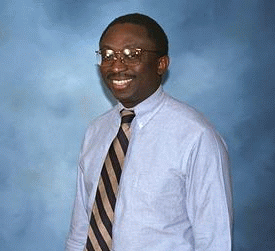

Akintunde Ibitayo (Tayo) Akinwande

birth:
place: Nigeria
![]() BSc(1978) Electrical
and Electronics Engineering from the University of Ife, Nigeria;
then MS(1981) and Ph.D(1986) Electrical Engineering, Stanford
University
BSc(1978) Electrical
and Electronics Engineering from the University of Ife, Nigeria;
then MS(1981) and Ph.D(1986) Electrical Engineering, Stanford
University
![]() Ph.D(1986) Electrical
Engineering , Stanford University
Ph.D(1986) Electrical
Engineering , Stanford University
![]() Full Professor,
I T T Career Development Associate Professor, MIT Electrical Engineering
and Computer Science
Full Professor,
I T T Career Development Associate Professor, MIT Electrical Engineering
and Computer Science
URL: http://c2s2.ece.cmu.edu/team/bio/akinwande.php
OR http://www-mtl.mit.edu/bin/user?akinwand
email: akinwand@MTL.MIT.EDU
Akintunde Ibitayo (Tayo) Akinwande joined the Department of Electrical Engineering and Computer Science at MIT in January 1995 as an Associate Professor. His research interests are in the areas of flat panel displays, vacuum microelectronics, and wide bandgap semiconductors. His current focus is on intelligent displays that utilize smart pixels. Recent accomplishments include demonstration of very low voltage operation field emission arrays using the smallest gate aperture and radius ever reported and a technique of increasing resolution and brightness of emissive displays.
Prior to joining MIT, Professor Akinwande was a Staff Scientist at the Honeywell Technology Center in Bloomington, MN. While he worked at the Honeywell Technology Center in Minnesota, Tayo Akinwande pioneered the development of thin-film-edge Field Emitter Arrays for RF Micro-Triode Power Amplifiers and Flat Panel Displays and demonstrated the feasibility of using the thin-film-edge FEA for these applications. In contrast to classical field emitters, the thin-film-edge emitter is based on a thin-film of metal (100 - 300 Å) and the maximum radius of curvature is about half the thickness of the film. He adapted the thin-film edge for the fabrication of a high brightness lamp that can be used as a backlight for avionic active matrix liquid crystal displays (AMLCDs) that are sunlight readable and can adapt to any environmental conditions. The result is a very bright and diffuse light source. The results of these research efforts have been reported at various conferences.
In 1989, he developed the first viable Complementary GaAs Heterostructure FET technology (a GaAs analog of CMOS) that demonstrated the lowest power-delay ever reported for a semiconductor technology (1.5 fJ) at a gate length of 1 µm. A 4K SRAM operating at 250 MHz with low power dissipation was demonstrated. He also developed GaAs heterostructure FET technology for high speed digital signal processing. He demonstrated a DFT chipset consisting of a 500 MHz Complex Multiplier and a 250 MHz Butterfly Adder. These are the highest speed LSI circuits ever reported at that time (1988). He gave an invited paper at the 1989 IEDM on the technology. Other research accomplishments include demonstration of very low threshold GaAs VCSEL and high brightness UV LEDs.
In 1989, he received the Sweatt Award-Honeywell's highest technical award for his work on the DFT processor chip set.
expertise: Flat panel display technology
research area: Display devices, vacuum microelectronic devices, and wide bandgap semiconductor devices.
Quote 1: "Silicon on plastic was inevitable," says MIT professor Akintunde Akinwande. "This technology could be used to create foldable computer displays." Initial uses will be for the military, because that's where the money is, says Akinwande. "The military can pay prices of $100,000," for sophisticated flexible computer screens, while "the consumer market needs prices of under $1,000... Sheets of this material could be put on a wall to create a (constantly changing) environment." (Investor's Business Daily 23 Dec 98)
Quote 2: Member of the Boston Pan-African Forum, established to educate and mobilize the African American and African Diaspora communities and influence the content and conduct of the United States foreign policy toward Africa: A.I. "Tayo" Akinwande, associate professor of electrical engineering at MIT, indicated that Africans are finding that Western methods are not working and people are saying, We need to go back to the old ways. The discussions, he said, do not center on rights, but on responsibilities. The issue is not so much about "having land as it is about taking care of land because it was once my grandfather's."
references: Akintunde Akinwande's web page; Investor Business Daily(23 Dec 98); newsletter from Boston Pan-African Forum; email correspondence with Chukwuka Aduba
![]()
| This website was created by and is maintained
by Dr. Scott Williams, Professor of Mathematics State University of New York at Buffalo |
|
|
|
|